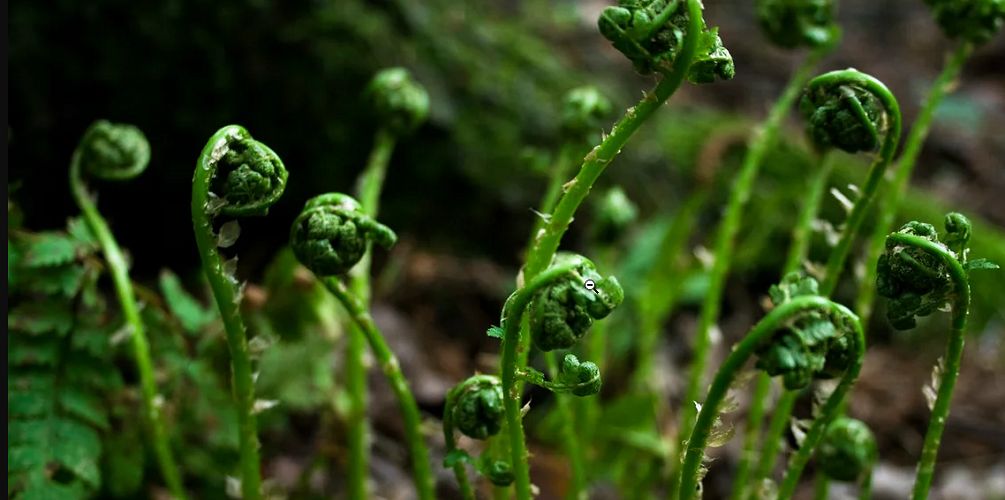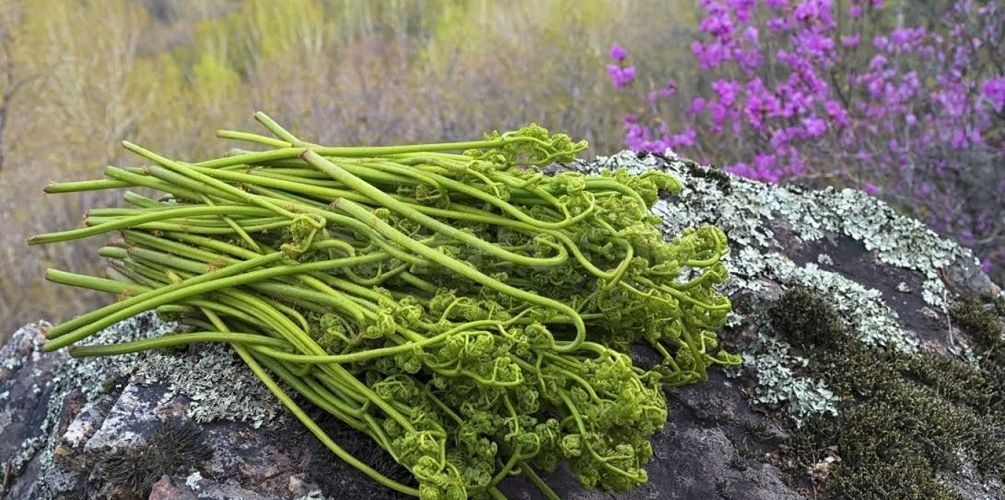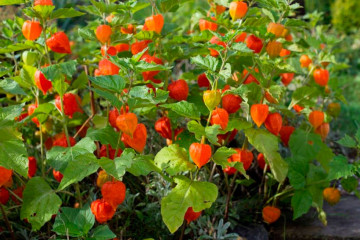Edible bracken fern - what it looks like and where it grows
Content:
Ferns are the oldest tree and ground cover plants on planet Earth, which have managed to preserve not only the appearance and structure, but also the diversity of species. They live in all corners of the Earth, except for Antarctica, the desert. They withstand drought, humidity, high and low temperatures, and are resistant to environmental changes.
Despite the fact that in the modern environment, ferns no longer prevail in the plant world, do not have huge sizes, they amaze with their originality and mysterious beauty. An interesting representative of them is the Orlyak fern.
Fern species
Ferns gradually entered human life, not only as wild or exotic plants. They are used as a home or ornamental crop. In addition, they have proven themselves well in the pharmacological field, traditional medicine.
Distinguish between poisonous (having a toxic effect on the human body) and edible species of ferns.
Edible ferns:
- Matteuccia struthiopteris - Common ostrich. The frond is shaped like an ostrich feather, the leaves are located at the top of the root. Distributed in central Russia, Transbaikalia, Altai in coniferous forests, water bodies.
- Osmunda asiatica - Asian Osmunda. A small plant with short, straight pagons. Distributed in the Primorsky Territory.
- Pteridim aquilnum - Orlyak, common fern. A single leaf crop does not produce shrubs. It inhabits almost the entire territory of Russia in coniferous and broad-leaved forests.
Poisonous ferns:
- Druopteris - Shield;
- Athurium - Kochedzhnik.
The rhizomes of these fern species contain particles of fluroglycin, a potent toxin.
Fern Eagle
One of the most famous and widespread Ferns on the planet is the Orlyak fern - a beautiful bright plant, it can decorate any corner in the garden, forest or near a pond.
The culture is used in folk medicine - a decoction from the shoots is used to relieve stress, remove radionuclides, eliminate fever, and strengthen the skeleton. The decoction of the roots has an anthelmintic effect, relieves joint aches, and helps with diarrhea.
The main characteristics of the culture:
- What does the bracken fern look like? Common bracken is a perennial herb of the Dennstedtiye family. A distinctive feature when describing a fern is frond, shaped like the wings of an eagle with tips curled inward. Usually Orlyak reaches 70 cm in height, but in more favorable climatic conditions (Primorsky Krai) it grows above a meter. The root system is well developed, located deeply, due to which the plant grows rapidly, adapts to any climatic features - the roots do not freeze, they are not afraid of drought, rainfall and even fires.
- Where does the bracken fern grow? The culture is found in all corners of the globe, except for Antarctica and the desert, and is widespread in Russia: in the middle zone, in Siberia, the Urals, the Far East, and the Primorsky Territory.Habitat - coniferous (pine) and deciduous (birch) forests, as well as edges, hills, water bodies. It grows well on pastures, clearings, abandoned fields. Prefers sandy, light soil, limestone. In some countries, the fern multiplies at such a fast rate that it is fought like a weed.
- How to grow Orlyak at home? Fern is a beautiful original plant that can decorate a corner in the house or an alpine slide in the garden. It is unpretentious, adapted to different climatic conditions, undemanding in maintenance. Bracken is able to reproduce by dividing the bush, spores, rhizomes, processes. Spore reproduction is a long and painstaking process, which is rather difficult to implement at home. The best way to grow a crop is to use a dividing bush or plant shoots by the root. In this case, you need to carefully examine how the fern looks like: stem, leaves, root system. They must be resilient, free from stains and damage.
To plant Eaglet in a pot, it is necessary to prepare a sandy substrate, lay out drainage from gravel or bricks on the bottom. The plant is transplanted into the garden in the spring in a shaded place, protected from drafts. Sand, a little ash should be added to the soil, small pebbles should be placed on the bottom.
When pests appear (scale insects, whiteflies, thrips), insecticides are used. It is not worth trimming the crown - the old pagons are replaced with new ones in the spring.
How to prepare and store a fern
Bracken is an edible fern. In Russia, it is little used, dishes from this plant are considered exotic. In the world, especially in Japan, such an unusual cuisine for Europeans is very developed, the Orlyak pagon snack is a fairly popular and familiar dish.
The shoots of a young fern - rachis are used for food. They appear in early May and resemble a snail in their appearance - the top of the petioles is wrapped in a spiral. Shoots are harvested before the first leaves appear - a mature plant becomes poisonous.
For cooking, use rachis no more than 30 cm, they are cut at a height of 5 cm from the ground. The sprouts are sorted by color and size, aligned along the top edge, tied, cut off exactly the bottom. You can keep the stems fresh for no more than 10 hours after harvesting; it is necessary to start harvesting rachis for the winter in 2-3 hours - this way the maximum number of useful things is preserved.
Pagon salting is carried out for industrial production. At home, the fern is harvested by drying, freezing or pickling.
Fern drying
Drying the sprouts allows you to preserve the original taste of the plant. Dense and large shoots up to 20 cm long are selected, pre-blanched in salted water for several minutes, then transferred to a colander, washed with cold water - this helps to maintain the elasticity and juiciness of the fern.
It is very important not to overcook the rachis, otherwise they will become tasteless and stratified. When the shoots have cooled down, the remaining moisture will drain off, you can start drying.
There are two ways to dry the resulting workpiece:
- Outdoors. The process is lengthy and rather painstaking. It is necessary to prepare a well-ventilated dry area, place the fern on paper or in a special mesh for drying vegetables. For 5-7 days, the sprouts periodically turn over, knead slightly.
- In an electric dryer. Express procurement method. Prepared shoots are placed in an electric dryer in a thin layer and dried at a temperature of 50 degrees for about 6 hours. You should be careful - the drying time largely depends on the size of the pagons.It is better not to dry them slightly than to dry them out and lose the results of labor.
Dried pagons are placed in fabric bags, which are suspended and remain in the fresh air for another couple of days to dry at natural temperature and humidity.
A very important nuance in the preparation is how to store the dried fern. Shoots are placed in paper or cloth bags and left in a dark, dry room. If the humidity is high, it is better to transfer the pagons to a glass container that closes tightly. In this state, the product retains its qualities for two years.
Freezing fern
A simple and effective method to prepare shoots that practically do not differ in appearance and taste from a fresh product is to freeze ferns:
- sprouts are selected, washed, cut into convenient pieces.
- blanched in salt water, reclined in a colander, washed with ice water.
- after the liquid is removed from the glass shoots, they are dried on a towel or paper, and cooled.
- ready-made rachises are transferred to food zipp-bags or plastic containers, placed in the freezer.
Another interesting way to prepare Orlyak is to marinate. To do this, boiled salted sprouts are laid out in jars and poured with marinade with soy sauce, apple cider vinegar, garlic, sugar and salt.
The result is a delicious snack reminiscent of pickled mushrooms.
Cooking edible fern
Bracken is a healthy and tasty plant that is widely used in oriental cuisine. It can be used to prepare salads, soups, snacks, stews and fried dishes. Shoots of young fern go well with rice, noodles, vegetables, meat and seafood. Bracken has a positive effect on the digestion process, is rich in vitamins, besides, its calorie content is quite low - 34 kcal.
Roasted fern recipes
In almost all recipes, you can cook fresh, frozen, dried and salted ferns. You just need to take into account some of the nuances: it is recommended to soak dried pagons in warm water for several hours, salted ones - it is necessary to rinse thoroughly.
With onion
Cut 2 medium onions into half rings, fry in vegetable oil until golden brown, add 500 g of boiled fern cut into small pieces to a frying pan, fry for a few minutes. This is a simple yet delicious dish. If desired, you can add carrots, season with sour cream and mayonnaise. Seasoned with soy sauce for a Korean-style fern.
With potato
300 g of boiled sprouts should be fried until crispy, put on a plate. Put 500 grams of potatoes, cut into long pieces, into a frying pan, fry until tender. Season with salt, pepper, add prepared fern. If desired, you can add onions, garlic. The potato takes on a delicious mushroom flavor.
With meat
The meat is cut into thin slices, marinated with salt, pepper, soy sauce. Onions are cut in half rings, fried in vegetable oil, put on a plate. Meat is laid out in a pan, fried until golden brown, and brought to half-readiness.
Prepared shoots are placed on the meat, onions are added. If you wish, you can put out the dish with sour cream or soy sauce, add sesame seeds.
If the fern is bitter
In the process of cooking rachis, you can face a common problem - the fern tastes bitter, radically changing the taste of the dish.How easy is it to remove bitterness from a fern? It's very simple: soak the shoots for several hours in salted water, change the water a couple of times.
Then rinse the pagons well and boil them for 6-9 minutes with the addition of salt. Such sprouts are ready for consumption or further harvesting and storage.
The bracken fern is not only a beautiful plant. It can be grown at home, decorated with an alpine slide or a corner in the garden. In addition, the culture is valued for its beneficial properties and is used in medicine. Bracken is an edible fern, delicious dishes are prepared from it, fried, pickled, harvested for the winter.

























